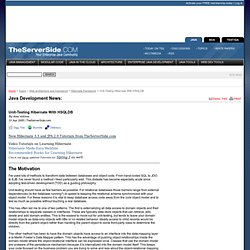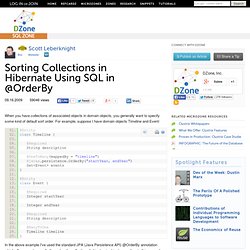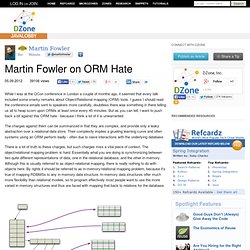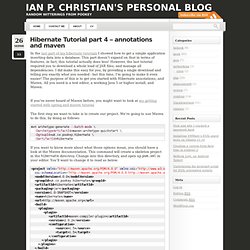

Unit-Testing Hibernate With HSQLDB. New Hibernate 3.5 and JPA 2.0 Tutorials from TheServerSide.com Video Tutorials on Learning HibernateHibernate Made Easy WebSiteRecommended Books for Learning Hibernate Check out these updated Tutorials for Spring 3 as well.

The Motivation I've used lots of methods to transform data between databases and object code. From hand-coded SQL to JDO to EJB. I've never found a method I liked particularly well. Unit-testing should have as few barriers as possible. This has often led me to one of two patterns. The other method has been to have the domain objects have access to an interface into the data-mapping layer a la Martin Fowler’s Data Mapper pattern. My current project involves crunching a number of baseball statistics and running simulations with the data.
Sorting Collections in Hibernate Using SQL in @OrderBy. When you have collections of associated objects in domain objects, you generally want to specify some kind of default sort order.

For example, suppose I have domain objects Timeline and Event: Chapter 19. Improving performance. Martin Fowler on ORM Hate. We Recommend These Resources While I was at the QCon conference in London a couple of months ago, it seemed that every talk included some snarky remarks about Object/Relational mapping (ORM) tools.

I guess I should read the conference emails sent to speakers more carefully, doubtless there was something in there telling us all to heap scorn upon ORMs at least once every 45 minutes. But as you can tell, I want to push back a bit against this ORM hate - because I think a lot of it is unwarranted. The charges against them can be summarized in that they are complex, and provide only a leaky abstraction over a relational data store. Their complexity implies a grueling learning curve and often systems using an ORM perform badly - often due to naive interactions with the underlying database.
There is a lot of truth to these charges, but such charges miss a vital piece of context. [#HHH-6578] BasicFormatterImpl Null Pointer Exception - Hibernate JIRA. Hibernate Tutorial part 4 – annotations and maven. In the last part of my hibernate tutorials I showed how to get a simple application inserting data into a database.

This part doesn't expand on that in terms of features, in fact, this tutorial actually does less! However, the last tutorial required you to download a whole load of JAR files, and manage all dependencies. I did make this easy for you, by providing a single download and telling you exactly what you needed - but this time, I'm going to make it even easier! The purpose of this is to get you started with Hibernate annotations, and Maven.
All you need is a text editor, a working Java 5 or higher install, and Maven. If you've never heard of Maven before, you might want to look at my getting started with spring and maven tutorial. Activejdbc - Implementation of Active Record pattern in Java. Inspired by Ruby on Rails ActiveRecord. The Bell That Rings Inside Your Mind, Is Challenging The Doors Of Time, It’s A Kind Of Magic (A Kind Of Magic - Queen) During class design we should take decisions about the assignment of responsibilities that will have every class. If we have chosen well, systems tend to be easier to understand, maintain and extend. Almost all of our projects have a persistence layer, either relational database, document stores, or simply XML files. And typically you will use DAO pattern to implement abstract interface between your business objects and your data store.
In this post but I am going to explain another pattern that can be used instead of DAO pattern. Active record pattern is an architectural pattern that force you to implement CRUD operations on your model class, hence model class itself is responsible for saving, deleting, loading from database. There are many strategies to follow to implement this pattern, but for me, the best one is using Aspect Oriented Programming, because we are still maintaining separation of concerns favoring isolated unit testing, and not breaking encapsulation. Hibernate Annotations.
2.2.

Mapping with EJB3 Annotations EJB3 entity beans are plain POJOs. Actually they represent the exact same concept as the Hibernate persistent entities. Their mappings are defined through JDK 5.0 annotations (an XML descriptor syntax for overriding will be defined in the EJB3 specification, but it's not finalized so far). Annotations can be split in two categories, the logical mapping annotations (allowing you to describe the object model, the class associations, etc.) and the physical mapping annotations (describing the physical schema, tables, columns, indexes, etc).
EJB3 annotations are in the javax.persistence.* package. For more and runnable concrete examples read the JBoss EJB 3.0 tutorial or review the Hibernate Annotations test suite. 2.2.1. Every bound persistent POJO class is an entity bean and is declared using the @Entity annotation (at the class level): Depending on whether you annotate fields or methods, the access type used by Hibernate will be field or property.
Chapter 24. Hibernate Best Practices.